| Bringing Vintage Aircraft to Life since 2010 |
|
|
 |
|
|
|
Since the introduction of the roundel on Royal Flying Corps aircraft in 1914 it has undergone various changes and modifications depending on the time period and type of aircraft being used and the role it performed. Whilst appearing in various guises during the First and Second World Wars after this period there have been less modifications to the roundel. Read about the history of the Royal Air Force roundel from 1914 to present day with images for each one. OriginsAircraft had been used for military purposes in the years preceding the First World War (1914 - 1918) in small numbers, however when war broke out on the 28th July 1914 aircraft would be used on a wide scale for the first time. This brought a new challenge for pilots and ground forces with the need to identify friendly and hostile aircraft quickly.
It was during the first months of the First World War that this need to identify quickly became a pressing issue as a number of 'friendly fire' incidents occurred. The first solution implemented by the Royal Flying Corps, the precursor to the Royal Air Force, was to paint the Union Jack on the underside of the lower wing. Whilst at low-level this was adequate in enabling identification of the aircraft by ground forces, at higher altitude less of the flag was visible leading to misidentification. The solution to this problem was suggested in a memo on the 29th October 1914 circulated by Major General David Henderson, Commanding Royal Flying Corps, British Army in the Field which was to copy a system used by the Armee de l'Air. This was a circle consisting of a red outer ring then white with a blue circle in the middle, the RFC version would have the blue and red reversed and be painted onto the wings only. On the 12th November 1914 the wing roundel was officially introduced for all Royal Flying Corps aircraft and was followed on the 23rd June 1915 with a decision that the roundel should appear on the fuselage as well, replacing the Union Jack. This has been the standard roundel ever since. Detailed below are the various roundels used by the Royal Flying Corps, later the Royal Air Force, since they were introduced during 1914. First World War Roundels The first means of identifying Royal Flying Corps aircraft was using the Union Jack. However, this ceased due to misidentification at high altitude with the German Maltese Cross. 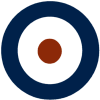 Copying the idea used by the French Air Service of a national cockade in the form of a roundel on aircraft but reversing the colours used by the French on their aircraft. 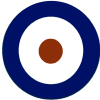 Same colours as the RFC (1914 - 1918) roundel but using brighter versions. 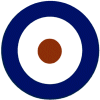 After camouflage had been painted onto the aircraft, around the outside of the roundel a white outline was added. Interwar Years Roundels As aircraft camouflage changed to help aircraft blend into their surroundings, blue would be the prevalent colour with a red circle in the middle. 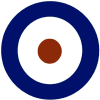 The standard interwar roundel was the same as the one used by the Royal Flying Corps between 1916 – 1918. 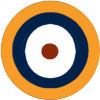 Painted onto all the camouflaged surfaces of an aircraft until March 1939.  The same design as the night bomber (1918 – 1938) roundel but appearing on top of the wings only. Second World War Roundels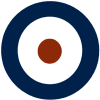 Painted on the fuselage of aircraft, until superseded by the next two roundels, but would still be used on the underside of aircraft until 1942. 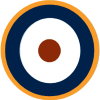 The standard interwar (1920 – 1939) roundel with a yellow ring added to make identification of friendly aircraft easier. 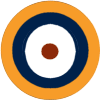 The same as the camouflaged surfaces (1937 – 1939) roundel but painted onto the fuselage only until July 1942.  Painted on both bombers that operated at night and night fighters on the fuselage.  Used on photo reconnaissance aircraft painted in PRU Blue or 'high altitude' camouflage colours. 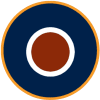 Also appeared on the top of the wing, if it was a dark colour, of selected aircraft.  Used on aircraft which had light surfaces.  The standard fuselage roundel but with the red inside removed, to avoid confusion with Japanese aircraft, but soon superseded by the next roundel.  With Japanese aircraft having red on their aircraft this two-tone blue roundel was introduced for aircraft being used in the Far East to make distinguishing between friendly and enemy aircraft easier.  With Royal Air Force aircraft involved in helping the RAAF defend Australia, they also had the same roundel to aid in identification. 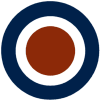 This was originally selected to be the standard post-war roundel but in 1947 the Vice Chief of the Air Staff rejected it. Post-War Roundels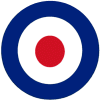 The current standard RAF roundel.  Used on the three aircraft that made up the RAF's V-Force, the Vulcan, Victor and Valiant, when they were painted in anti-flash white. 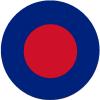 Used since the 1970s for aircraft painted in traditional camouflage design. 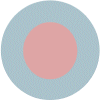 With modern aircraft normally painted in a grey colour this low visibility roundel was introduced. 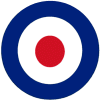 Same as the current standard roundel, but with a white outline.  To be used by the Royal Air Force squadrons operating the F-35B Lightning II. This will differ more from previous roundels as it will be built into rather than painted onto the aircraft.
< Back to articles |
|
|
|
||||||||||||||
|